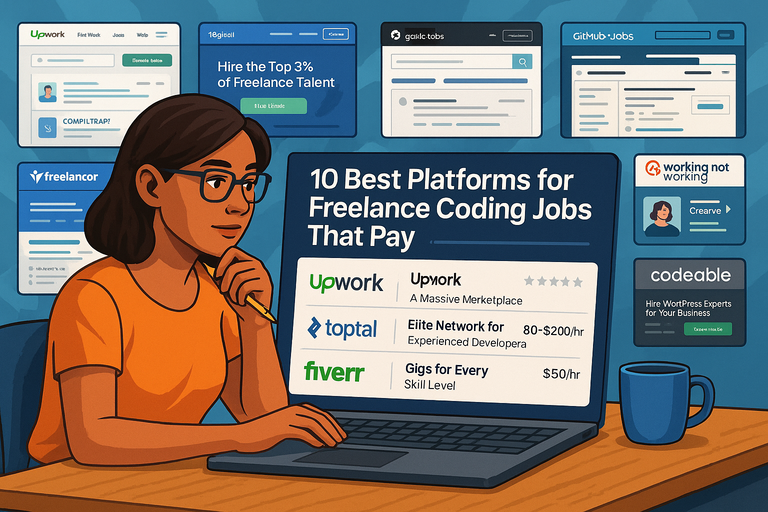Table of Contents
Freelance coding has become one of the most flexible and rewarding ways for developers to earn a living. But with so many platforms out there, which ones actually help coders land jobs that pay well? That’s the question I’ll be answering here.
In this guide, you’ll discover the top platforms that connect skilled programmers with clients willing to pay for quality work. Whether you’re looking for long-term contracts, small gigs, or remote coding projects, these platforms open doors to real opportunities.
1. Upwork: A Massive Marketplace for Freelance Coding
Upwork is often the first stop for many freelancers because it’s one of the largest online marketplaces. With thousands of active projects posted daily, it offers both short gigs and long-term contracts.
The challenge, though, is standing out in a sea of other coders. Here’s how you can make the most of Upwork if you’re serious about freelance coding.
Building a Strong Profile That Attracts Clients
Your Upwork profile is essentially your shop window. Clients decide in seconds if you look like the right fit. I recommend focusing on three key areas:
- Headline & Overview: Instead of a vague headline like “Web Developer,” make it specific and results-driven, such as “Full-Stack Developer Specializing in Scalable Web Apps.” Your overview should read less like a résumé and more like a pitch — explain how you solve problems, not just what you’ve studied.
- Portfolio Samples: Even if you haven’t worked on paid projects yet, create sample projects. For example, a mock e-commerce site with login and cart functionality or a clean API integration. Screenshots and links matter more than words.
- Keywords & Skills: Upwork’s search algorithm favors profiles optimized with relevant terms. Sprinkle in phrases like “Python developer,” “React.js,” or “REST API integration,” but make them natural.
I’ve seen coders with no previous clients land jobs purely because their profiles looked sharp and professional. Think of your profile as a mini-website that markets you.
How to Set Competitive Rates Without Undervaluing Skills
Pricing is one of the hardest parts of starting on Upwork. Beginners often undercut themselves to “get a foot in the door,” but that strategy can backfire. Clients who shop for the cheapest option often bring the most headaches.
Here’s a smarter approach:
- Research the Market: Search for other developers with your skill set and see what they charge. For example, junior developers might range from $15–$30 per hour, while experienced full-stack coders land anywhere from $60–$120 per hour.
- Use Tiered Pricing: If you’re unsure where to start, set your base hourly rate slightly lower but offer fixed-price packages at higher rates. That way, you attract entry-level clients while signaling you’re worth more.
- Adjust Over Time: Once you’ve completed 5–10 projects with positive reviews, raise your rates. I’ve seen coders double their rates within six months by steadily building credibility.
Pro tip: Clients are often more willing to pay higher rates if you frame your service as solving a business problem rather than just “writing code.” For example, “I optimize site speed to improve conversions” sounds more valuable than “I write clean HTML and CSS.”
Tips for Winning Coding Projects on Upwork
Even with a polished profile and solid pricing, winning projects takes strategy. I’ve noticed that many freelancers fail not because of skill, but because of how they pitch.
- Write Personalized Proposals: Never use a copy-paste cover letter. Instead, mention something specific from the job description. For instance, if the client wants a custom booking system, you could write, “I’ve built a similar system for a client in the travel industry — I can show you the demo.”
- Respond Quickly: Upwork rewards fast responders. Many jobs get dozens of applications, and clients often hire the first qualified person who replies.
- Show Small Wins: If the project feels too big, propose starting with a smaller milestone. For example, instead of “I’ll build your entire web app,” suggest, “Let’s begin with the login system, and we’ll expand once you’re happy with the workflow.”
When you combine speed, clarity, and proof of skill, you’ll rise above the “race to the bottom” crowd.
2. Toptal: Elite Network for Experienced Developers
While Upwork casts a wide net, Toptal takes the opposite approach. It’s a premium freelance platform that markets itself as connecting clients with the “top 3% of freelance talent.”
This isn’t a place for beginners — it’s where experienced coders go when they’re ready to work with big clients and command high pay.
Why Toptal’s Screening Process Sets It Apart
Getting into Toptal is tough, and that’s exactly why clients trust it. The screening process involves:
- Language & Personality Interview: They want to see if you can communicate clearly with clients.
- Timed Coding Tests: These are algorithm-heavy challenges, similar to what you’d find in technical interviews at big tech companies.
- Live Screening: You’ll solve real-world problems while sharing your screen with an evaluator.
- Test Projects: Before being fully accepted, you complete a paid test project that mimics what you’d do for a client.
Only a small fraction of applicants make it through, which means if you get in, you’re automatically positioned as a top-tier freelancer. Clients feel confident paying higher rates because they trust Toptal’s vetting.
Types of Freelance Coding Projects Found on Toptal
Toptal attracts larger companies, startups with serious funding, and established brands. That means the projects you’ll see here are very different from the $100 bug fixes often found on general platforms.
Common project types include:
- Long-term contracts: For example, being hired as a remote full-stack developer for 20–30 hours per week over several months.
- Specialized builds: High-performance applications, enterprise SaaS platforms, or scalable backend systems.
- Niche expertise roles: Think blockchain developers, machine learning engineers, or DevOps specialists.
I’ve noticed that Toptal projects are less about “tasks” and more about integrating into a client’s existing development team. If you like collaboration and consistency, this can be a huge plus.
Earning Potential for Skilled Developers on Toptal
Let’s talk numbers. On Upwork, rates can be all over the place. On Toptal, clients expect to pay a premium.
- Typical Hourly Rates: Developers often charge between $60–$150 per hour depending on their expertise.
- Long-Term Contracts: A 6-month contract at 25 hours per week, even at $80/hour, works out to $8,000 per month — not bad for remote freelance coding.
- High-Demand Skills: Niche specializations like blockchain or AI can push rates even higher, sometimes beyond $200/hour.
What makes Toptal appealing is the stability. Instead of juggling dozens of small gigs, you can land one or two high-paying clients and focus on delivering value.
In my opinion, if you already have several years of coding experience and enjoy working with structured teams, Toptal is one of the most reliable ways to turn freelance coding into a full-fledged career.
3. Fiverr: Freelance Coding Gigs for Every Skill Level
Fiverr is often misunderstood. Some people think it’s only for “cheap gigs,” but that’s far from the truth. In reality, it’s a place where you can package your coding skills into services clients can buy instantly — like an online shop for your expertise.
Whether you’re just starting out or you’re an experienced developer, Fiverr gives you a platform to showcase what you do best.
Setting Up Gigs That Stand Out in Search
When you create a gig on Fiverr, think of it like designing the front page of a product you’re selling. Your gig has to catch the eye and instantly tell potential buyers what you do.
- Gig Title: Keep it clear and keyword-friendly. Instead of “I will code for you,” go specific: “I will build responsive websites using React and Node.js.” That clarity helps you rank in Fiverr search.
- Thumbnail Image: Don’t ignore visuals. Create a clean, simple thumbnail with bold text like “Custom Web App Development” so clients instantly know what you offer. I advise using Canva if you’re not a designer.
- Search Tags: Use all five slots. If you’re offering a WordPress service, include variations like “WordPress developer,” “custom theme coding,” “WordPress bug fix.”
In practice, when I set up my first Fiverr gig, I noticed I got more clicks when the title included the exact wording clients were searching for. The search bar is your best friend here — type in “coding” and see what auto-completes. Those are the goldmine keywords.
Choosing Packages That Showcase Coding Expertise
Fiverr lets you create three pricing tiers: Basic, Standard, and Premium. Instead of making them random, design them so they naturally lead a client to pick the higher-value package.
For example:
- Basic ($50): Fix one small bug or add a simple feature.
- Standard ($200): Develop a custom landing page or single module.
- Premium ($500+): Build a full web application with multiple features.
This approach lets clients self-select based on their budget while showing the full scope of your expertise. I suggest including delivery time and number of revisions in each tier.
A clever trick is making your Standard package feel like the “best value” so more buyers choose it over Basic.
Proven Ways to Build Reviews and Boost Visibility
Fiverr thrives on social proof. Without reviews, your gigs might get lost. The trick is building momentum.
- Start With Smaller Gigs: Offer simple services at an affordable price for your first few clients. Once you’ve built a handful of 5-star reviews, raise your prices.
- Deliver Fast: Overdeliver whenever you can. If the gig says three days, try sending it in one or two. Quick turnarounds often lead to glowing reviews.
- Stay Responsive: Fiverr tracks your response rate. I suggest downloading the Fiverr app so you can reply within minutes — it boosts your ranking.
One coder I worked with doubled his Fiverr visibility by consistently delivering early and asking satisfied clients politely if they’d leave a review. A steady stream of positive reviews signals to Fiverr’s algorithm that your gigs deserve higher placement.
4. Freelancer.com: A Global Platform for Coding Projects
Freelancer.com is one of the oldest freelancing platforms, and while it’s not as polished as Upwork, it still has a massive global reach.
You’ll find coding projects ranging from small bug fixes to large enterprise-level contracts. Success here comes down to how well you navigate the bidding system and choose your niches.
How Bidding Works for Freelance Coding Jobs
On Freelancer, most projects work through bidding. A client posts a project, freelancers submit proposals with their rate, and the client chooses. The challenge is competing against dozens of bids, sometimes from people charging unbelievably low rates.
Here’s how I suggest approaching it:
- Don’t Always Bid Lowest: Clients often ignore the cheapest offers because they fear poor quality. Aim for mid-range pricing.
- Customize Your Proposal: Always mention specifics from the job description. If they need a PHP fix, include a line like, “I recently fixed a similar issue with WordPress sites where plugins broke after an update.”
- Use Milestones: Break your bid into phases, like “$200 for initial setup, $300 for final delivery.” This shows structure and reassures clients you won’t vanish halfway.
The platform also allows contests, where clients post a project and freelancers submit work directly. If you’re confident in your skills, contests can be a great way to get visibility quickly.
Strategies to Win Competitive Projects
To stand out in a crowded marketplace, you need more than just skills. You need tactics.
- Bid Quickly: Projects often get swamped within hours. Setting up mobile notifications helps you respond fast.
- Build a Standout Profile: Upload real project screenshots and detailed descriptions. Include measurable outcomes like “reduced page load time by 40%.”
- Leverage Repeat Clients: Once you land a project, nurture that client relationship. Returning clients save you from constantly competing in the bidding pool.
I believe trust is the currency here. If a client knows you deliver reliably, they’ll come back to you directly instead of posting new projects.
Best Coding Niches to Focus on for Steady Work
Not every niche pays equally on Freelancer. Some areas are overcrowded, while others are in high demand. From what I’ve seen, the following niches perform best:
- Web Development (React, Angular, Node.js): Endless demand, especially for small business websites.
- Mobile Apps (iOS/Android): Clients with startup ideas constantly look for coders to build MVPs (minimum viable products).
- WordPress Customization: From theme fixes to plugin development, WordPress jobs are everywhere.
- API Integrations: Companies often need help connecting their apps to third-party services like Stripe, PayPal, or Zapier.
If you’re unsure where to start, WordPress and general web development are safe bets. But if you specialize in something less common, like blockchain or machine learning, you can command much higher rates.
5. GitHub Jobs: Coding Opportunities for Developers
GitHub Jobs may not look as flashy as Fiverr or Upwork, but if you’re serious about freelance coding and connecting with reputable companies, this platform can be a hidden gem.
The beauty is that it taps directly into GitHub’s massive developer ecosystem, which means the people hiring usually understand what they need — and they value technical talent.
How GitHub Jobs Connects Developers with Companies
GitHub Jobs works like a specialized job board. Companies post opportunities, and developers can browse by role, tech stack, or location (with plenty of remote listings).
Unlike gig marketplaces where you compete against dozens of random bids, here you apply directly to positions where coding skill is the main currency.
When I first explored GitHub Jobs, I noticed the listings weren’t just “bug fixes” or small tasks. Instead, you’ll often find:
- Contract roles to join a startup’s dev team.
- Short-term freelance projects for app development.
- Remote backend and frontend builds with clear requirements.
This setup makes it less of a “race to the bottom” and more about showing you’re the right fit. Companies that post on GitHub Jobs are often already familiar with open-source communities, which means they expect quality, not bargain pricing.
Highlighting Skills to Attract Technical Recruiters
Since many recruiters browsing GitHub Jobs are technical themselves, your resume or portfolio needs to be more than buzzwords. I suggest focusing on three things:
- GitHub Profile: Treat it like your public portfolio. Pin repositories that showcase your best work — for example, a custom API integration or a React app with clean commits.
- Project Documentation: Recruiters love clear documentation. If you’ve built something, include a README that explains setup, features, and your role in the build.
- Tech-Specific Keywords: If a listing asks for Django, don’t just say “Python experience.” Mention “Django REST framework for scalable APIs” — it signals real expertise.
One trick I’ve used: Contribute to open-source projects in the same ecosystem as the job you’re targeting. When a recruiter sees your username pop up in their world, it creates instant credibility.
Remote Freelance Coding Roles Found on GitHub
Many GitHub Jobs listings are remote-friendly, making it a great fit if you want flexibility. These roles can range from part-time freelance coding gigs to ongoing contracts.
Common examples include:
- Remote API Development: Startups often need someone to connect third-party services into their platform.
- Front-End Roles: React, Vue, and Angular jobs are consistently posted.
- DevOps & Infrastructure: If you enjoy setting up CI/CD pipelines or managing servers, companies are willing to pay well.
In practice, I’ve seen developers land multi-month contracts where they’re essentially embedded into a team, but still freelancing. That balance of stability and freedom is one of the reasons GitHub Jobs attracts serious coders.
6. PeoplePerHour: A Hub for Short-Term Coding Gigs
PeoplePerHour is like the middle ground between Fiverr and Upwork. It’s especially popular in Europe and caters to freelancers who want short, project-based gigs rather than long-term contracts.
If you like variety in your coding work, this platform can keep things interesting.
Creating Offers That Match Market Demand
On PeoplePerHour, you don’t just wait for clients to post jobs — you can also create “Offers” that act like pre-packaged services. The key is matching these offers with what clients are already searching for.
Here’s a strategy I recommend:
- Use the search bar to see what coding services clients post most (e.g., “WordPress bug fix,” “custom Shopify coding”).
- Create offers around those needs. For example: “Fix Any WordPress Error in 24 Hours” or “Develop a Custom Shopify App.”
- Price offers smartly — enough to attract clients but not so low you undervalue yourself.
The “Offer” model is powerful because it lets clients buy your service instantly without a bidding war.
How to Attract Clients Searching for Coders
Visibility on PeoplePerHour comes down to your profile and how active you are. Clients often search by skill, so make sure your profile includes:
- A clear tagline like “Full-Stack Developer Specializing in Scalable Web Apps.”
- A portfolio section with screenshots of real projects. Even small fixes can become case studies if you explain the before-and-after.
- Keywords in your bio that reflect in-demand skills like “Node.js,” “Shopify,” or “custom APIs.”
Another tip: Respond quickly to invitations. PeoplePerHour tracks responsiveness, and higher ratings push you up in search results.
Managing Multiple Small Projects Effectively
Since PeoplePerHour is heavy on short-term gigs, you’ll often juggle multiple projects at once. Here’s how I recommend handling that without burning out:
- Use a Project Tracker: Even a simple Trello board can keep you organized when handling three bug fixes and two small app builds at the same time.
- Batch Communication: Instead of answering client messages as they come in, set aside time blocks twice a day to respond. It keeps you sane.
- Template Deliverables: For recurring work (like fixing WordPress bugs), create reusable scripts or checklists. This saves hours in the long run.
I once saw a coder handle five micro-projects in a week by using a repeatable system. Clients were happy with the fast turnaround, and the freelancer earned a steady stream of reviews — which in turn boosted visibility.
7. Gun.io: Freelance Coding Jobs for Top Tech Talent
Gun.io is a bit different from other freelance coding platforms. It brands itself as a community for serious developers who want high-quality clients.
The goal here isn’t to land $50 bug fixes — it’s to get connected with startups and companies willing to pay top rates for reliable freelancers.
The Vetting Process and What to Expect
Gun.io, like Toptal, screens freelancers before admitting them. The process typically includes:
- An application review where you outline your experience.
- A technical interview or coding test to validate your skills.
- Profile setup that highlights your strengths to potential clients.
The screening isn’t meant to scare people away — it’s there to ensure clients get developers they can trust. In my view, this is actually a good thing, because once you’re in, you’re competing with far fewer people than on massive platforms like Upwork.
Project Types Offered on Gun.io for Freelancers
The projects on Gun.io are usually larger and more structured than you’d find on gig platforms. Examples include:
- Building MVPs (Minimum Viable Products) for funded startups.
- Expanding features on existing SaaS platforms.
- Long-term development roles, often remote, where you work as part of a distributed team.
If you’re someone who likes meaningful projects with continuity, Gun.io is a great fit. Clients here are less likely to post one-off bug fixes and more likely to bring you into their dev ecosystem for weeks or months.
Why Clients on Gun.io Pay Above Average Rates
The simple answer is trust. Clients know that if you’re on Gun.io, you’ve been vetted. They don’t have to sift through dozens of random bids — they get matched with coders who’ve already proven their skills.
Rates here are significantly higher than general freelance sites. From what I’ve seen, developers often charge $75–$150 per hour, and niche expertise (like blockchain or advanced AI) can go even higher.
I believe Gun.io works well for freelancers who want fewer, higher-quality clients rather than juggling lots of smaller gigs. It’s a platform built on relationships and reliability, not volume.
8. FlexJobs: Remote-Friendly Freelance Coding Projects
FlexJobs is different from typical gig marketplaces. Instead of scrolling through endless low-paying offers, you get a curated list of remote opportunities — freelance coding included.
It’s built for people who want security and legitimacy, without the scams or shady listings that pop up elsewhere.
Finding Legitimate Freelance Coding Opportunities
What I like about FlexJobs is how much time it saves. You don’t have to wonder if a job is real — they’ve already filtered out fake or exploitative postings. This makes it a safer bet for developers who don’t want to waste time.
When you search for freelance coding roles on FlexJobs, you’ll often find:
- Ongoing part-time contracts with established companies.
- Remote coding tasks for startups that need quick help.
- Tech support or QA testing roles that can supplement dev income.
The beauty is that everything has already been vetted, so you can focus on applying instead of worrying if you’re dealing with a scammer.
How FlexJobs Curates and Verifies Job Listings
Behind the scenes, FlexJobs has a team that hand-screens every single listing. They check for:
- Company legitimacy.
- Proper contracts and payment reliability.
- Roles that match remote-first work setups.
It’s a paid service, but I believe the fee is worth it. You’re paying for peace of mind and a higher chance of landing stable, well-paying projects. For me, that beats wasting hours filtering through junk listings on free platforms.
Balancing Freelance Coding with Long-Term Remote Roles
FlexJobs shines if you’re someone who wants stability alongside freelancing. A common path is combining:
- Freelance projects for extra income and flexibility.
- Part-time remote roles for steady pay and predictable hours.
I’ve seen developers stack a consistent 20-hour remote contract with freelance side gigs. That way, you get the best of both worlds: security and variety. If you like balance, FlexJobs gives you that runway.
9. Codeable: WordPress-Focused Freelance Coding Jobs
If your coding expertise leans heavily toward WordPress, Codeable is hands down one of the best platforms.
Unlike general marketplaces, it’s entirely focused on WordPress projects — and clients come here specifically looking for serious developers, not bargain hunters.
Why Codeable Specializes in WordPress Projects
WordPress powers nearly half of all websites online, so demand is massive. Codeable carved out a niche by focusing only on this ecosystem — themes, plugins, custom builds, migrations, you name it.
That means clients on Codeable already understand the value of specialized WordPress work. You’re not competing with generalists, which often translates into higher pay and less friction.
How Developers Are Matched with Clients
Codeable has a unique matching process. Instead of bidding wars, projects are posted, and the platform pairs clients with the best-suited developers. This saves you from constantly undercutting others just to win jobs.
The key steps are:
- Client posts a project with clear details.
- Codeable suggests a developer (or a small pool of developers) based on expertise.
- You connect directly, set expectations, and start the work.
I suggest keeping your profile very specific here. If you’re strongest in plugin development, say so clearly — it increases the chances of Codeable matching you with the right client.
Earning Consistently Through WordPress Freelance Work
On Codeable, consistency is easier because most clients return for follow-up work. Once you’ve proven reliable, you can become their go-to WordPress developer.
For example, a client who hires you to optimize their site speed might later need help setting up WooCommerce or integrating third-party APIs. That’s recurring business without hunting for new clients every week.
Rates on Codeable are higher than on broad platforms. Developers often charge $70–$120 per hour, which adds up quickly when you’re landing steady projects. If you want a predictable flow of WordPress-focused freelance coding jobs, this is one of the best choices.
10. Contra: A Portfolio-Driven Platform for Independent Coders
Contra is built for independent professionals who want freedom without the clutter of traditional freelancing sites. It blends the polish of a creative network (like Working Not Working) with the practicality of a job marketplace.
Developers can create sleek, visual portfolios and collaborate directly with startups, creative studios, and tech-driven brands — no commissions involved. Contra emphasizes project-based contracts and highlights your verified work experience through “Recommendations,” making it ideal for coders with design sense or UX experience.
Why it fits: Contra attracts the same creative-tech crossover crowd that used Working Not Working but with a more freelancer-friendly model and zero platform fees.
Expert Tip to Maximize Earnings from Freelance Coding
The platform matters less than your positioning. Whether you’re on Upwork, Toptal, Codeable, or Working Not Working, clients ultimately hire people they trust to solve problems. My biggest piece of advice? Build a strong personal brand.
- Keep your portfolio polished and updated.
- Showcase results, not just skills.
- Overcommunicate during projects to build trust.
- Reinvest in relationships with repeat clients — they’re the ones who bring consistent income.
From my experience, freelance coding success isn’t about chasing every project. It’s about choosing the right platforms that fit your skills, presenting yourself professionally, and delivering so well that clients can’t imagine working with anyone else. That’s how you move from scrambling for gigs to building a stable, thriving freelance career.






